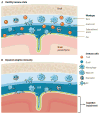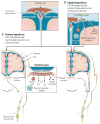Multifaceted interactions between adaptive immunity and the central nervous system
- PMID: 27540163
- PMCID: PMC5590839
- DOI: 10.1126/science.aag2638
Multifaceted interactions between adaptive immunity and the central nervous system
Abstract
Neuroimmunologists seek to understand the interactions between the central nervous system (CNS) and the immune system, both under homeostatic conditions and in diseases. Unanswered questions include those relating to the diversity and specificity of the meningeal T cell repertoire; the routes taken by immune cells that patrol the meninges under healthy conditions and invade the parenchyma during pathology; the opposing effects (beneficial or detrimental) of these cells on CNS function; the role of immune cells after CNS injury; and the evolutionary link between the two systems, resulting in their tight interaction and interdependence. This Review summarizes the current standing of and challenging questions related to interactions between adaptive immunity and the CNS and considers the possible directions in which these aspects of neuroimmunology will be heading over the next decade.
Copyright © 2016, American Association for the Advancement of Science.
Figures




References
Publication types
MeSH terms
Grants and funding
LinkOut - more resources
Full Text Sources
Other Literature Sources
Medical

